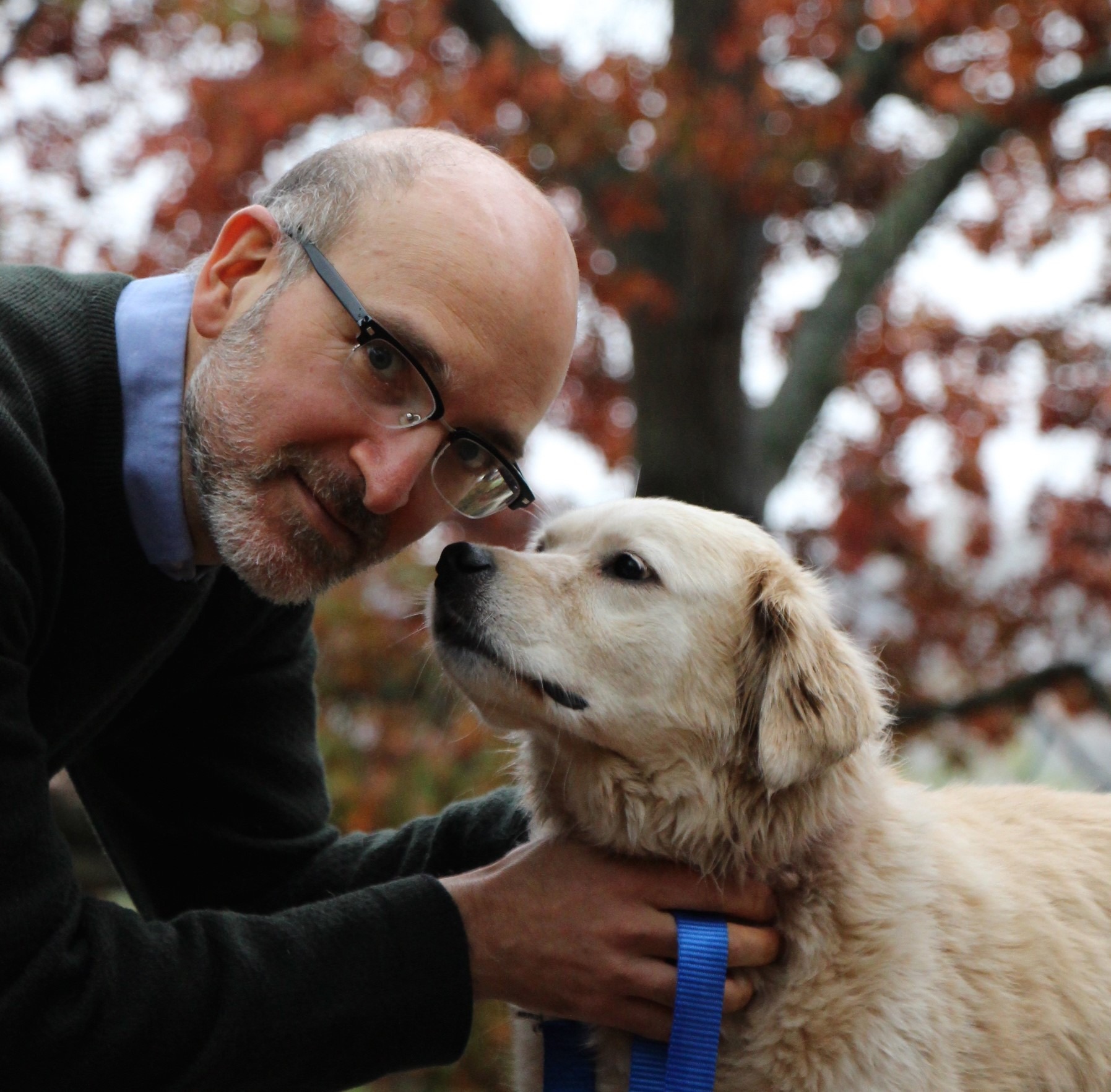
Dr. Daniel Promislow, biogerontologist and The Dog Aging Project’s principal investigator, with Frisbee: ‘People love dogs,’ the Doctor points out. ‘That’s a huge motivation for the 47,000 people who have joined our project so far.’
By Duncan Strauss
When you gaze across the living room and see the family pooch snoozing on the couch, it probably makes you happy, maybe makes you smile, might make you envious. It’s unlikely to make you think “Well, there’s a participant in a major scientific study.”
But you could have this thought. Because that fictional napping dog-or your real one-could indeed be participating in a significant scientific investigation: The Dog Aging Project, a long-term study of health and longevity in dogs.
“Like a lot of really exciting science, it got started by being inspired by someone else’s work,” Dr. Daniel Promislow, a biogerontologist and The Dog Aging Project’s principal investigator, said of the study’s origin in a Talking Animals interview.

Join the Dog Aging Project: The Dog Aging Project is recruiting dogs to participate in the largest canine health study ever conducted. This is an opportunity to be part of a research project that can dramatically extend what we know about health and aging in our dogs. Join at https://dogagingproject.org
“A paper came out in Science–it’s the premier science journal in the country–from Elaine Ostrander’s group on the genetics of size in dogs. Couldn’t miss it: The cover had a picture of a Great Dane and a Chihuahua walking side-by-side. What she and a researcher in her lab, Nathan Sutter, discovered is that this huge variation we see in size in dogs is due in large part to a single gene called IGF-1.
“That came out in 2007. I work on aging. It really piqued my interest because I also know that IGF-1, that same gene, is associated with aging. I thought, ‘Gee, maybe that explains why large breed dogs are sadly not as long-lived as the toy breeds.’ At the time, I was just up the road from [Talking Animals’ Tampa studio] at the University of Georgia. I reached out to my colleague in the vet school, Kate Creevy. That was in 2007, and the rest is history.
Not so fast, Dr. Promislow!
Dogs aging, especially aging far enough where they cross The Rainbow Bridge, is of enormous interest to millions and millions of us. And if this has any implications for the aging of other species-like us grizzled humans, for example–we’re further intrigued by The Dog Aging Project, and how it came together. So, please don’t gloss over any key details, Doc.
“Well, once Dr. Creevy and I met,” Promislow continued, “it was just immediately clear that dogs are the perfect species to study aging, as variable as they are. Any of your listeners will know, you go to the dog park and look around, and they’re the most variable mammal in the world. Compare that Chihuahua and that Great Dane.
“And not just in size, but in behavior, in shape, in color, in everything we can measure, including how they age. There are long-lived breeds and short-lived breeds. The diseases that they encounter as they age vary from breed-to-breed, but those risks increase with age, just like in us. So hugely variable. They age like us.
“They, of course, have a sophisticated healthcare system with almost all the specialties that human healthcare has. And they live in our environment, so there’s also the opportunity not only to uncover the genetics of aging, but also to identify risk factors from the environment.
“Because they share our environment, those risk factors are likely to be risk factors for us as well. So they’re really the perfect species to study aging. Most important of all, of course, people love dogs. That’s a huge motivation for the 47,000 people who have joined our project so far.”

The Dog Aging Project Update with Professor Matt Kaeberlein
That figure is not a mistake. No typo there, no errant zero. Indeed, some 47,000 people had enrolled their dog in the study–since the very first enrollee in 2020-as of this conversation with Dr. Promislow several months ago. Since then, that number has climbed to 50,000.
Most of us, whether we’re dog lovers or not, don’t think of canines as the animals occupying the center of a scientific study-that’s typically the domain of mice and rats, and in a thankfully-bygone era, chimpanzees, among others.
But dogs? Counterintuitive as it might seem, it appears Promislow is suggesting that dogs-our everyday companion and best friend (when not chewing through our new sneakers)-make for an ideal subject for studying aging, both for their numerous similarities to humans, and the sweeping variability across their own breeds.
“I mean, it’s the similarities and the shared environment,” Promislow said, signaling that I may indeed be understanding the pooch virtues for this kind of scientific investigation. “Also, the variation is really critical. All that variability creates an opportunity to discover what’s behind that variation.

In this web exclusive from CBS Sunday Morning, Texas A&M’s Kate Creevy, chief veterinary officer of the Dog Aging Project, talks about the long-term longitudinal study of healthy aging in dogs, including a clinical trial of the drug rapamycin to test its effects on cognitive function, muscle strength, activity levels, and heart health, in the hopes of maximizing a dog’s ‘health span.’
“There is a cat aging project in England. I love that people are studying cats as well. Cats are harder to study, partly because they live longer than dogs. So it would take that much longer to learn about what’s going on with the aging process. But also, they’re not as variable. We don’t have 200-pound cats in the house–probably a good thing…
“But there’s a lot that’s really special about dogs. This is a natural species, it’s not in a lab environment. And they’re connecting with us, what your podcast is all about. That’s such a powerful motivator.”
OK, so we’ve probably arrived at an understanding of the initially surprising, yet supreme value of dogs as scientific subjects, at least when it comes to this aging study. But what may remain perplexing is the staggering scope here: Why have Promislow and his colleagues amassed 50,000 enrollees, while remaining open to adding more?
Framed another way: What does 50,000 dogs tell you about aging? Or, what will it tell you about aging or longevity, that 40,000 or 45,000 dogs doesn’t tell you?
“Every dog ages a little bit differently,” he said. “There are some things that are very common, like skin disorders, super common in dogs. There are other things that are quite rare, but for those dogs that experience them, diseases can be really devastating. So the more dogs we have, the more power we have to study even those relatively rare diseases that are important when they happen.
“Also, to discover the underlying causes. For example, there are genes that might increase the risk of a particular disease, but only by a little bit. Because it’s only a little bit, to be able to capture that signal amongst the noise of all the variations–the more dogs the better.”

Dr. Daniel Promislow, co-director of the Dog Aging Project and professor of Laboratory Medicine and Pathology at the University of Washington School of Medicine, discusses his team’s massive project to study the aging processes of our canine companions. Running time: 1:18:36. Posted at YouTube by Louisiana Tech University.
Toward that end, Promislow outlines the criteria for joining the study, starting with needing the dog to live in America, adding, “Right now, we’re limited to the U.S. We hope to expand internationally.
“We welcome puppies all the way up to the oldest old dog–large, small, mixed breed, purebred. All you need to do is go to our website, which is dog aging project dot org. There, you can nominate your dog. You fill out a survey, telling us the story of your dog’s life. Its health, its environment, its behavior. Once you complete that survey, it takes an hour or two, you are a member of the Dog Aging Project Pack.”
Sounds pretty easy. So, now, when you glance across the room at the dozing dog, I hope you’ll demonstrate proper respect and let sleeping citizen scientists lie.
You can hear the Dr. Promislow interview on this edition of Talking Animals.
 Combining his passions for animals, radio, journalism, music and comedy, Duncan Strauss launched Talking Animals at KUCI in California in 2003. Since late 2005 the show has aired on Tampa’s WMNF. Producer-host Strauss lives in Jupiter Farms, FL, with his family, including four cats, two horses and one dog. He spends each day talking to those animals, and maintains they talk right back to him, a claim as yet unverified by credible sources.
Combining his passions for animals, radio, journalism, music and comedy, Duncan Strauss launched Talking Animals at KUCI in California in 2003. Since late 2005 the show has aired on Tampa’s WMNF. Producer-host Strauss lives in Jupiter Farms, FL, with his family, including four cats, two horses and one dog. He spends each day talking to those animals, and maintains they talk right back to him, a claim as yet unverified by credible sources.


